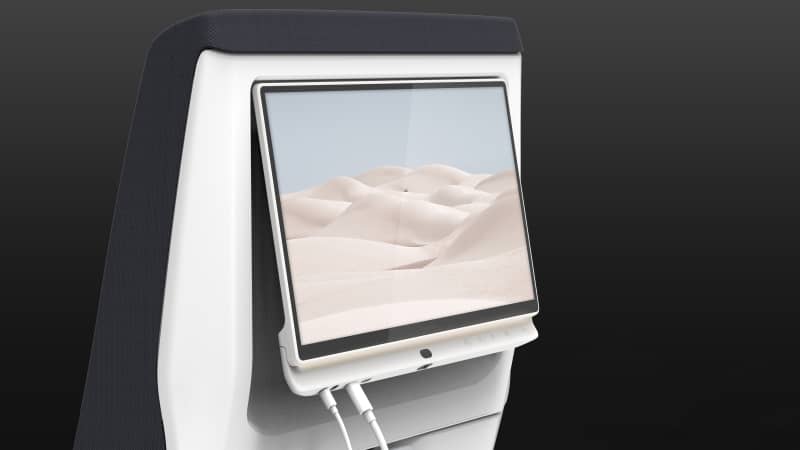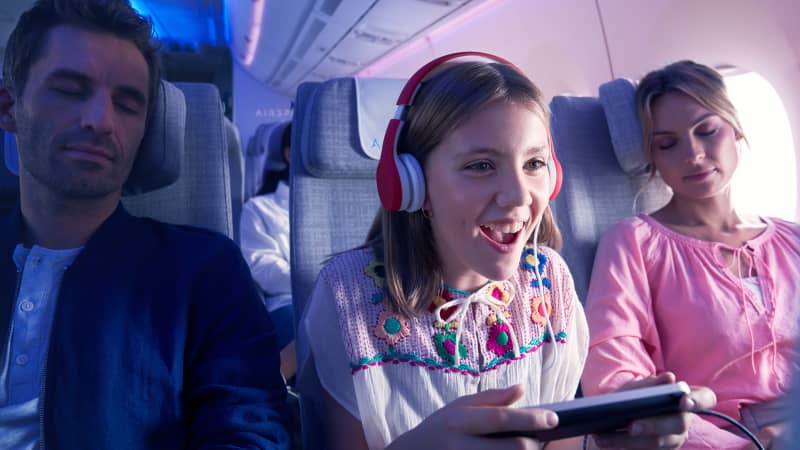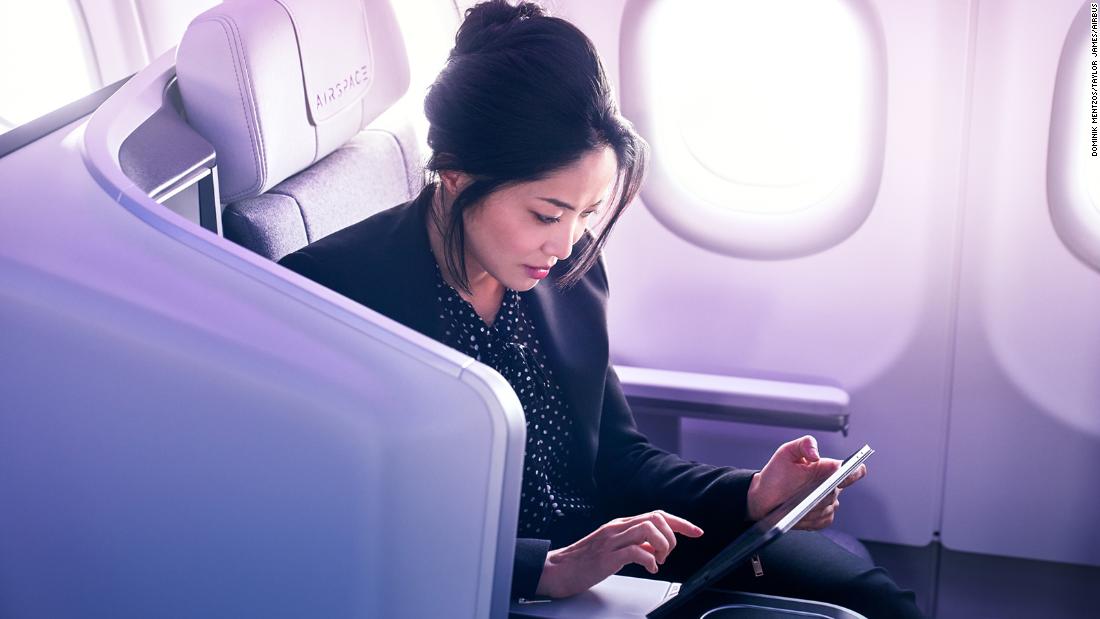(CNN) — Home entertainment today is defined by sleek, high definition flat screen televisions, voice controlled speakers, and cell phones that know us better than we know ourselves.
So when we board an airplane, decade-old, bulky inflight entertainment screens can feel like a hangover from another era.
Recent inflight entertainment concepts aim to revolutionize the current inflight experience, creating a personalized, high tech cabin of the future.
If big names like technology company Panasonic Avionics and aerospace corporation Airbus have their way, you’ll soon be able to enjoy personalized quirks like a tailor-made on board movie selection, interactive in-seat games and video chatting with flight crew at 30,000 feet.
Personalized cabins

Astrova is a swanky new inflight entertainment screen from Panasonic Avionics.
Panasonic Avionics
At the recent 2022 Aircraft Interiors Expo (AIX) in Hamburg, Germany, Panasonic Avionics unveiled Astrova, a next generation inflight entertainment (IFE) screen complete with microphone functionality for voice commands, and an optional built-in camera with a sliding privacy cover.
This manual on-off switch is Panasonic’s attempt at alleviating concerns around cameras on airplanes, which came to a head in 2019 when passengers discovered lenses in existing, Panasonic-designed seat back IFE screens.
Panasonic defended these cameras, explaining they were there to future-proof aircraft, in case airlines wanted to implement concepts such as seat-to-seat video conferencing further down the line.
“I believe it’s going to settle down, that the case to be made for positive benefits coming from cameras is stronger than any concern that they could possibly be used for nefarious purposes,” said Bartlett, who has since left the company.
Three years on, the Astrova screen reignites the conversation around cameras on airplanes, but Panasonic hopes the on-off switch will resolve any disquietude.
Speaking to CNN Travel at AIX 2022, Brian Bardwell, Panasonic’s corporate communications leader, suggested “there probably were some lessons learned” from the public response in 2019.
The physical shutter will be “very obvious,” explained Panasonic’s vice president of product and portfolio management, Andy Masson, who showed CNN Travel a model of Astrova at AIX. Masson added that passengers will be given detailed instructions on how to use the camera.

Astrova’s camera includes a manual on-off slider switch.
Panasonic Avionics
Astrova also comes in a cameraless form too, and it’s ultimately up to airlines to decide if they want the feature installed. Panasonic suggests the camera option could allow for interactive games for passengers, and in-seat communication with cabin crew.
“An airline, we want to give them the option to be able to wrap their personalization elements — understanding you, your desires, previous activations of the IFE system — to then drive content that is interesting for you, or drive games that might be interesting for you, or drive applications that might be interesting to you,” said Masson.
Passengers will be able to manually switch off cameras, and they’ll also be able to opt out of this IFE data collection. But Masson thinks many travelers desire an onboard experience that’s as personalized as possible, given it’s what they are used to at home.
“I generally feel that people, when they get on board, are really looking for that engagement, and they will do what is necessary to get that engagement,” he said.
The SITA report quizzed travelers from 27 countries in the first quarter of 2022, looking at how they used technology at every stage of their journey, including booking, transiting airports and inflight.
Panasonic’s Astrova is set to premier on Qatar Airways’ Boeing 777X aircraft, with the airline to install 22-inch versions in its business cabins, and 13-inch screens in economy.
Astrova, which is kitted out with cinema-grade 4K OLED screens, includes Bluetooth technology to allow travelers to link personal devices, and charging ports for laptops, tablets and phones.
CNN Travel understands Qatar Airways has opted for the cameraless version of Astrova.
Panasonic’s microphone functionality also allows passengers to use voice commands to search IFE content, like they might with Siri on an iPhone. This, plus the camera, could enable passenger-to-crew video conferencing, although CNN Travel understands no airlines are currently interested in implementing this feature.
Creating a “flying smartphone”

Airspace Link is am Airbus concept that envisages making the whole aircraft a “flying smartphone.”
Dominik Mentzos/Taylor James/Airbus
The SITA report suggested that a majority of passengers use their cell phone, tablet and laptop inflight.
But IFE designers like Panasonic figure there’s scope to use personal devices in tandem with built-in screens. That’s how Astrova works, and a multi-screen approach also figures in Airbus’ newest cabin concept, Airspace Link, the latest iteration of its “connected cabin” approach.
Airspace Link is designed to transform the entire airplane cabin into a “flying smartphone,” as Airbus’ vice president of cabin marketing Ingo Wuggetzer told CNN Travel in a recent interview.
The result is a cabin where potentially everything is high tech — from overhead luggage bins that light up when they’re full, to an airplane seat tailored to your personal preferences.

Airspace Link could give travelers more personalized, interactive inflight entertainment options.
Dominik Mentzos/Taylor James/Airbus
IFE personalization options could include a tailored list of movie options, akin to the way the Netflix algorithm recommends movies based on your recent viewing habits. Travelers can install an app on their cell phone to get involved, or use a built-in IFE screen.
Airlines will then be able to track passenger data and figure out how they spend their time on board.
“It’s not new,” said Wuggetzer of this data-collecting. “It’s just that we apply the same things now on an aircraft.”
Airbus’ market research suggests younger fliers are open to their data being used in this way, but older generations may be more hesitant.
“In the end, you’ll probably also have the option to say no, if you don’t want it,” said Wuggetzer.
This is still a concept Airbus is experimenting with, but Wuggetzer says his designers aren’t looking at seat back camera options, at least not currently.
“Maybe that option is something that could be considered,” said Wuggetzer, adding that his team is aware of the previous IFE camera controversy, and any camera would always include a manual on-off switch.
He’s less convinced by in-seat microphones, namely because of the potential for noise disruption impacting other passengers.
Passenger perspective
Frequent flier and cybersecurity expert Vitaly Kamluk, whose Tweets spearheaded the cameras on planes conversation in 2019, told CNN Travel he is pleased with Panasonic’s on-off switch solution for its Astrova camera.
“I embrace their decision to address privacy concerns of many passengers,” said Kamluk.
“Any technology may be hacked one day. However, with reliable cover for video sensors such as cameras that is no longer a concern.”
More generally, Kamluk said he embraced the idea of a more personalized airplane cabin, whether that includes a camera, microphone or data collection, as long as privacy concerns are thoroughly considered.
“A camera with privacy control is a great addition to IFE,” he said.
“The need for privacy is here to stay with us. It didn’t change because of the pandemic and I hope that we will continue developing new technologies with the respect of users’ privacy as one of the foundational requirements for innovations.”
Top photo courtesy Dominik Mentzos/Taylor James/Airbus
